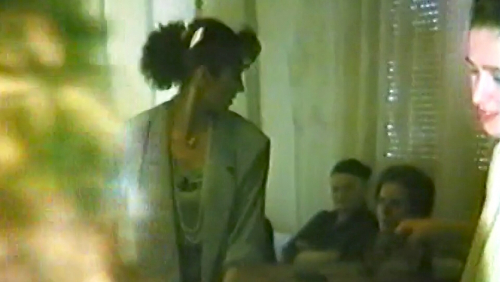05/08/2024
A sense of unease begins to dominate the moment the old cassette footage appears on the screen. As the narration progresses, you quickly realize that you've entered a puzzle with a bitter language and a difficult answer. Just as you start to think that the materialization of this archive is clarified by the presence of Nora's character, whom we meet in a rush, things start to get entangled in a wandering that will continue through every frame of the film. From this point on, questions arise that fit the story very well. Who is Nora? What is she trying to tell us?
In the linguistic conditions and the temporary reconstruction given to the archival material by the director Norika Sefa, infected messages of an indescribable absence are hidden, which become increasingly difficult to decode. This absence is so present throughout the film that I often found myself craning my neck with the feeling that something was hidden from me—perhaps in the objects or behind the furniture seen in the rooms.
Like A Sick Yellow is a reconstruction of family memories extracted from the cassettes, which seem to encompass various gatherings within this family. The domestic atmosphere where Nora and some of the film's characters live has been encountered before in the short film Kiss Me, Now. In this attempt to reinterpret the past, the director has completely destabilized the authority of the archive. By intervening in family memories, she has obscured the relationship between the characters, the characters and objects, the spaces and the items. Within the tension where the limit of what is said and what is meant to be said is tested, the entire burden falls on the viewer, who is involved in understanding the dialectic of the images.
With the whispering language around Nora's character, the collective fear of a story that is about to happen is documented. The hidden linguistic signs in the description of colors, the folkloric elements, and the superstitious signals dissolve Nora in the fleeting moments captured by the eye. Red is sometimes mixed into a long-sleeved dress, and sometimes in a dress that reveals the arms. This movable positioning of Nora places her in union with all other women. Her character spreads in all movements, dances, and the anticipation of guests to merge into a whole construct, almost like a ghost.
A repetitive montage of certain moments performs its effect well. The women continue to move like shadows, as if someone had directed their behavior. Thus, throughout the film, you easily remember the festivities with dances and the men drinking raki. You also distinguish the television, the applause, the cupboards, the tables with food, the lamps, and the balloons. Fear grows among the frames where the women disturb the regular order of the archive. In this restoration, they show us that something has gone; something may have escaped us.
Halfway through the film, we step outside for a bit longer, then return again to a festivity to end with the scenes that confirm Nora's state. Her hazy thoughts and questions quietly disperse across the hill, taking human forms that walk and disappear. In the absence of images, the terror continues on the black screen. Throughout the film, the viewer deciphers the response of the constructed atmosphere: the fear foretold by Nora.
By Blerta Haziraj
Translated by Plator Gashi
DOKUKINO PLATO
Time & Date
20:00 / Mon 5 Aug, 2024
KINO ABI ÇARSHIA
Time & Date
15:30 / Thu 8 Aug, 2024



